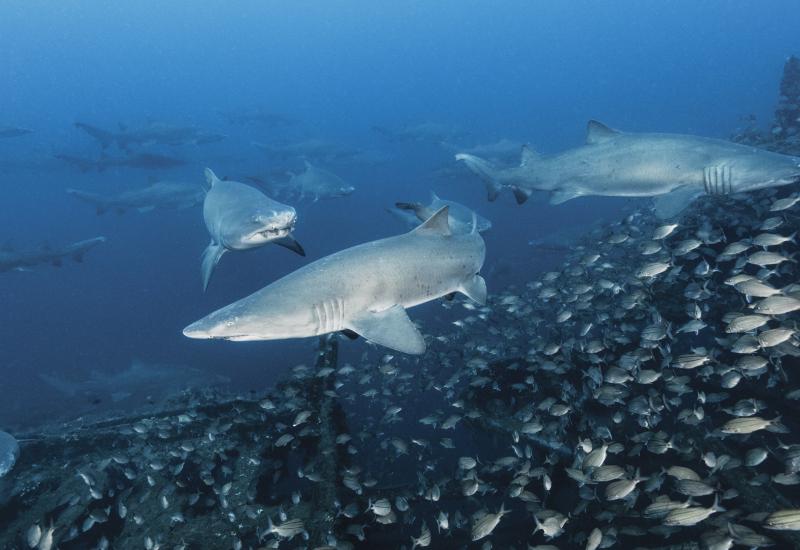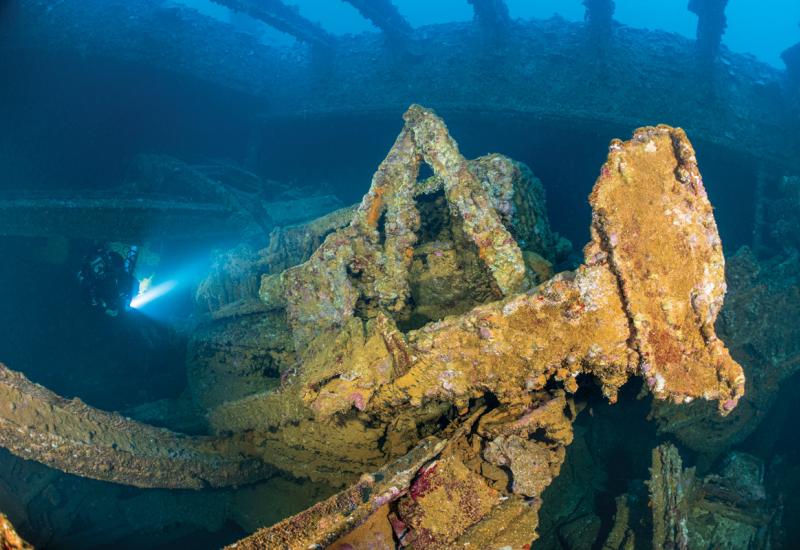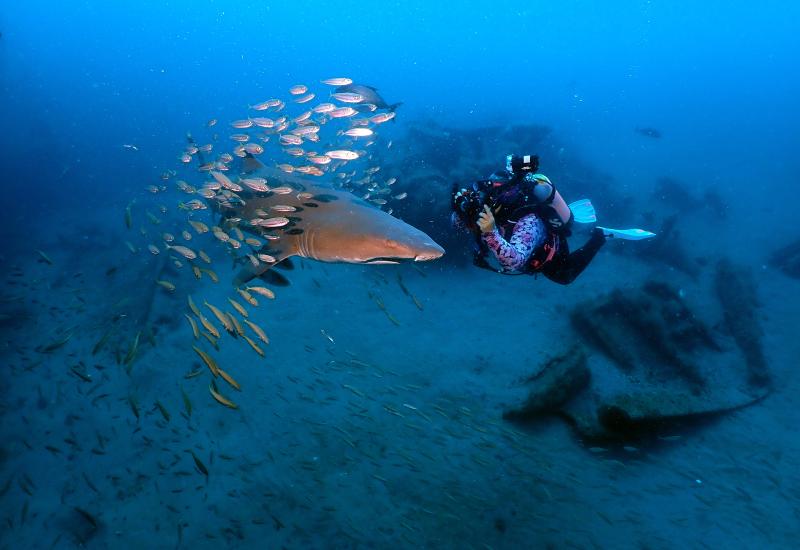Mysteries of the Outer Banks

November 2006
Text and photography by Walt Stearns
Out on the dock, the air feels slightly cooler than it's been. I'm thinking: Maybe today will be the day. A late-season cold front passed through last night, leaving a light fog hanging over coastal North Carolina and the Morehead City waterfront on this early May morning. The still air brings the sound of radio static as Capt. Bobby Purifoy of the dive boat Midnight Express speaks with fishing boats out near the tower on Frying Pan Shoals, some 30 miles offshore. They tell of three-foot waves. This is good news, because ever since my arrival four days ago, I've wanted to dive the U-352, but weather has made it impractical.
Even on the best days, the ride to the southern Outer Banks' premier wreck sites is a two-hour voyage. Today, it might take a bit longer, but conditions look favorable and we are good to go.
The coastal waters of North Carolina have earned the nickname "Graveyard of the Atlantic," and not without justification. Ships transiting along the Atlantic Seaboard must clear the treacherous shoals that extend east from Cape Hatteras, and ever since the early days of our nation, vessels have come to grief in these volatile waters--some 700 in all.
One could argue that a greater number of ships have perished elsewhere. Even the Great Lakes can boast more wrecks than the Carolinas. But what makes the wrecks off North Carolina's Outer Banks, from Cape Hatteras to Cape Fear, so interesting is that while half fell victim to the winds and waves of raging storms, the other half were sent to the bottom by human conflict, most notably during World War II.
Torpedo Alley
During the early years of World War II, Germany's marauding U-boats brought the Battle of the Atlantic right to our doorstep. The U-boats proved to be some of the most fearsome and effective weapons in the history of naval warfare. Under the command of Admiral Karl Donitz, Germany's U-Bootwaffe launched its first series of strikes against American vessels in the final days of 1941. Known as Paukenschlag, or Operation Drumbeat, the initial attacking force was comprised of five IX-class long-range boats.
Between their arrival in U.S. territorial waters, in early 1942, and Feb. 6, 1942, the U-boats sank 25 ships. By the close of that same year, U-boat operations had swelled along the U.S. continental shelf, where they ranged between Maine and the Florida Keys.
In response to this threat, Allied forces organized convoys and provided them with naval escorts. Homeland defense forces deployed long-range aircraft patrols and cruisers armed with depth charges, and developed sophisticated sub-hunting methods utilizing active sonar systems, radio triangulation and coded message intercepts.
Their efforts eventually made service aboard U-boats almost suicidal. By the end of 1942, more than 50 U-boats were destroyed. During the first months of the following year, nearly 100 boats were sunk, culminating in Black May, when 41 subs were killed and another 37 damaged. One of the victims of this onslaught was the U-352.
On May 9, 1942, it fired two torpedoes at the U.S. Coast Guard cutter Icarus. Dodging the salvo, the Icarus made its own attack, firing five depth charges that severely damaged the U-boat, wrecking the conning tower and blowing off its deck gun. Two more depth charge attacks forced the U-352 to the surface, where its commander ordered his crew to scuttle and abandon the ship. In the end, 17 crew were killed, with the rest taken to Charleston, S.C., as prisoners of war.
For a battle that was so well recorded, nobody knew the exact whereabouts of U-352 until Capt. George Purifoy of Olympus Dive Center and three close friends--Rod Gross, Dale McCullough and Claude Hall--decided to seek the downed sub. The hunt lasted 10 years before the sub was found in April 1975, a full mile and a quarter from the original coordinates logged by the Icarus. Today, it is one of North Carolina's signature wrecks, and the one that most visitors to Morehead City want to dive.
Today, anticipation builds on the ride out, but once there, patience is required while the crew situates the dive boat above the wreck. As is the case with most of the deeper wrecks in the area, the crew's greatest challenge is hooking onto the wreck. Before divers hit the water, a crewmember descends and manually ties onto the wreck, a procedure that can take 20 minutes or more in challenging conditions.
Once everything is secure, we are cleared to follow the descent line to the sub, which lies on the sand in 120 feet of water. Out of the haze, the U-352 materializes, sitting with a 45-degree list to starboard. Looking down at the 218-foot-long sub, my first impression is that it is surprisingly small. Life on a warship was anything but luxurious, but life on a U-boat strikes me as claustrophobic--even when no one was dropping explosives on you.
Through the years I have had the opportunity to dive a great number of wrecks around the world, most of which have been victims of storms and collisions with reefs--even a few that were sunk by German U-boats. But finally being able to see one of these man-made predators is a very special moment.
Home of the Sand Tigers
Not everyone who comes to dive North Carolina is here just for the wrecks. Others come to see sharks, namely sand tigers. Going face-to-face with one of these brutes is something not easily forgotten. Beneath their conical snouts are fearsome-looking jaws held partially agape as they brandish a nightmarish collection of spiky teeth.
But despite appearances, sand tigers are not monsters. There is little to fear from these slow-moving animals, which use their impressive dental assets to snare bottom-dwelling fish, not divers. Sand tigers were once a widely distributed species, found not only in North and South American waters, but Australia, South Africa, India, China and Japan. Even the Mediterranean was once known to have them before overfishing wiped them out.
These days, the most robust population of surviving sharks can be found in the waters of North Carolina. And the best place to find them is usually on a wreck. In fact, almost every wreck below 60 feet--W.E. Hutton, Suloide and Aeolus, to name a few--will attract sand tigers, and the farther out from shore, the higher their numbers.
It is the presence of sand tigers that has made the Papoose North Carolina's best-known wreck. Torpedoed by a German U-boat after rounding Cape Lookout on March 18, 1942, the 412-foot tanker lies upside down with her superstructure crushed into the sand bottom at 130 feet. Entry into the hull is possible through several openings, but penetration should be left to highly experienced and well-equipped divers.
For the most part, the ship's huge hull resembles a large watermelon, cracked open in several places, with the highest part of the wreck rising 30 feet off of the bottom at the stern. Back in the mid-1970s, salvagers managed to raise the propeller after blasting it loose from the shaft, in the process leaving a large void between the stanchion and rudder.
For fish-watchers, the wreck offers everything from large schools of spadefish, a variety of jacks, African pompano, sand tiger sharks, to--get this!--lionfish. Apparently jettisoned into the Atlantic by aquarium owners, this tropical Pacific native has made itself quite at home on most of the wrecks and deep-water ledges off the Outer Banks.
InDepth
Getting There: From I-95, the drive from the southwest on Hwy. 17 takes approximately two hours. It's about three hours if you are coming from Raleigh, six hours from Washington, D.C., and nine hours from Philadelphia.
Water Conditions: Water temps range from the low 60s to upper 60s during winter and spring and from the low 70s to the low 80s during the fall and summer. Visibility ranges from 40 to 50 feet in winter and from 80 to 100 feet in summer.
Dive Operators: Olympus Dive Center, Morehead City (252-726-9432, www.olympusdiving.com), Discovery Diving, Beaufort (252-728-2265, www.discoverydiving.com), Atlantis Charters, Beaufort (252-728-6244, www.atlantischarters.net).
Things To Do: North Carolina Aquarium, Pine Knoll Shores, Hwy. 58 west • Range of aquariums and exhibits including a Touch Tank.
The North Carolina Maritime Museum, 315 Front St., Beaufort • An impressive collection of ship models and various exhibits highlighting species of coastal birds, fish and marine mammals native to the region.
Cape Lookout National Shore, accessible only by ferry • A 55-mile-long barrier island that is uninhabited and undeveloped except for the Cape Lookout lighthouse and keeper's quarters. Outer Banks Ferry Service, (252) 728-4129.
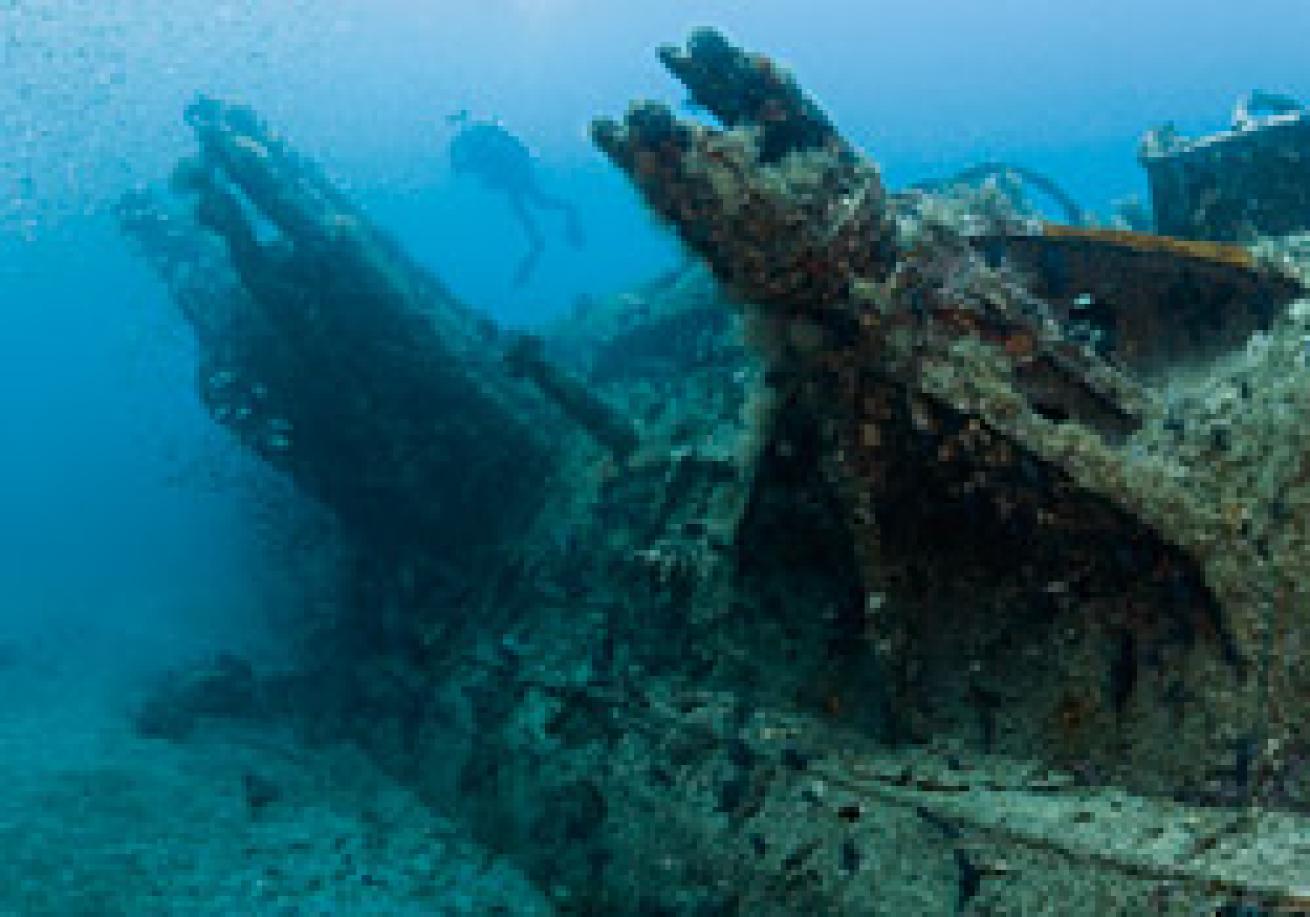
..
November 2006
Text and photography by Walt Stearns
Out on the dock, the air feels slightly cooler than it's been. I'm thinking: Maybe today will be the day. A late-season cold front passed through last night, leaving a light fog hanging over coastal North Carolina and the Morehead City waterfront on this early May morning. The still air brings the sound of radio static as Capt. Bobby Purifoy of the dive boat Midnight Express speaks with fishing boats out near the tower on Frying Pan Shoals, some 30 miles offshore. They tell of three-foot waves. This is good news, because ever since my arrival four days ago, I've wanted to dive the U-352, but weather has made it impractical.
Even on the best days, the ride to the southern Outer Banks' premier wreck sites is a two-hour voyage. Today, it might take a bit longer, but conditions look favorable and we are good to go.
The coastal waters of North Carolina have earned the nickname "Graveyard of the Atlantic," and not without justification. Ships transiting along the Atlantic Seaboard must clear the treacherous shoals that extend east from Cape Hatteras, and ever since the early days of our nation, vessels have come to grief in these volatile waters--some 700 in all.
One could argue that a greater number of ships have perished elsewhere. Even the Great Lakes can boast more wrecks than the Carolinas. But what makes the wrecks off North Carolina's Outer Banks, from Cape Hatteras to Cape Fear, so interesting is that while half fell victim to the winds and waves of raging storms, the other half were sent to the bottom by human conflict, most notably during World War II.

..
Torpedo Alley
During the early years of World War II, Germany's marauding U-boats brought the Battle of the Atlantic right to our doorstep. The U-boats proved to be some of the most fearsome and effective weapons in the history of naval warfare. Under the command of Admiral Karl Donitz, Germany's U-Bootwaffe launched its first series of strikes against American vessels in the final days of 1941. Known as Paukenschlag, or Operation Drumbeat, the initial attacking force was comprised of five IX-class long-range boats.
Between their arrival in U.S. territorial waters, in early 1942, and Feb. 6, 1942, the U-boats sank 25 ships. By the close of that same year, U-boat operations had swelled along the U.S. continental shelf, where they ranged between Maine and the Florida Keys.
In response to this threat, Allied forces organized convoys and provided them with naval escorts. Homeland defense forces deployed long-range aircraft patrols and cruisers armed with depth charges, and developed sophisticated sub-hunting methods utilizing active sonar systems, radio triangulation and coded message intercepts.
Their efforts eventually made service aboard U-boats almost suicidal. By the end of 1942, more than 50 U-boats were destroyed. During the first months of the following year, nearly 100 boats were sunk, culminating in Black May, when 41 subs were killed and another 37 damaged. One of the victims of this onslaught was the U-352.
On May 9, 1942, it fired two torpedoes at the U.S. Coast Guard cutter Icarus. Dodging the salvo, the Icarus made its own attack, firing five depth charges that severely damaged the U-boat, wrecking the conning tower and blowing off its deck gun. Two more depth charge attacks forced the U-352 to the surface, where its commander ordered his crew to scuttle and abandon the ship. In the end, 17 crew were killed, with the rest taken to Charleston, S.C., as prisoners of war.
For a battle that was so well recorded, nobody knew the exact whereabouts of U-352 until Capt. George Purifoy of Olympus Dive Center and three close friends--Rod Gross, Dale McCullough and Claude Hall--decided to seek the downed sub. The hunt lasted 10 years before the sub was found in April 1975, a full mile and a quarter from the original coordinates logged by the Icarus. Today, it is one of North Carolina's signature wrecks, and the one that most visitors to Morehead City want to dive.
Today, anticipation builds on the ride out, but once there, patience is required while the crew situates the dive boat above the wreck. As is the case with most of the deeper wrecks in the area, the crew's greatest challenge is hooking onto the wreck. Before divers hit the water, a crewmember descends and manually ties onto the wreck, a procedure that can take 20 minutes or more in challenging conditions.
Once everything is secure, we are cleared to follow the descent line to the sub, which lies on the sand in 120 feet of water. Out of the haze, the U-352 materializes, sitting with a 45-degree list to starboard. Looking down at the 218-foot-long sub, my first impression is that it is surprisingly small. Life on a warship was anything but luxurious, but life on a U-boat strikes me as claustrophobic--even when no one was dropping explosives on you.
Through the years I have had the opportunity to dive a great number of wrecks around the world, most of which have been victims of storms and collisions with reefs--even a few that were sunk by German U-boats. But finally being able to see one of these man-made predators is a very special moment.
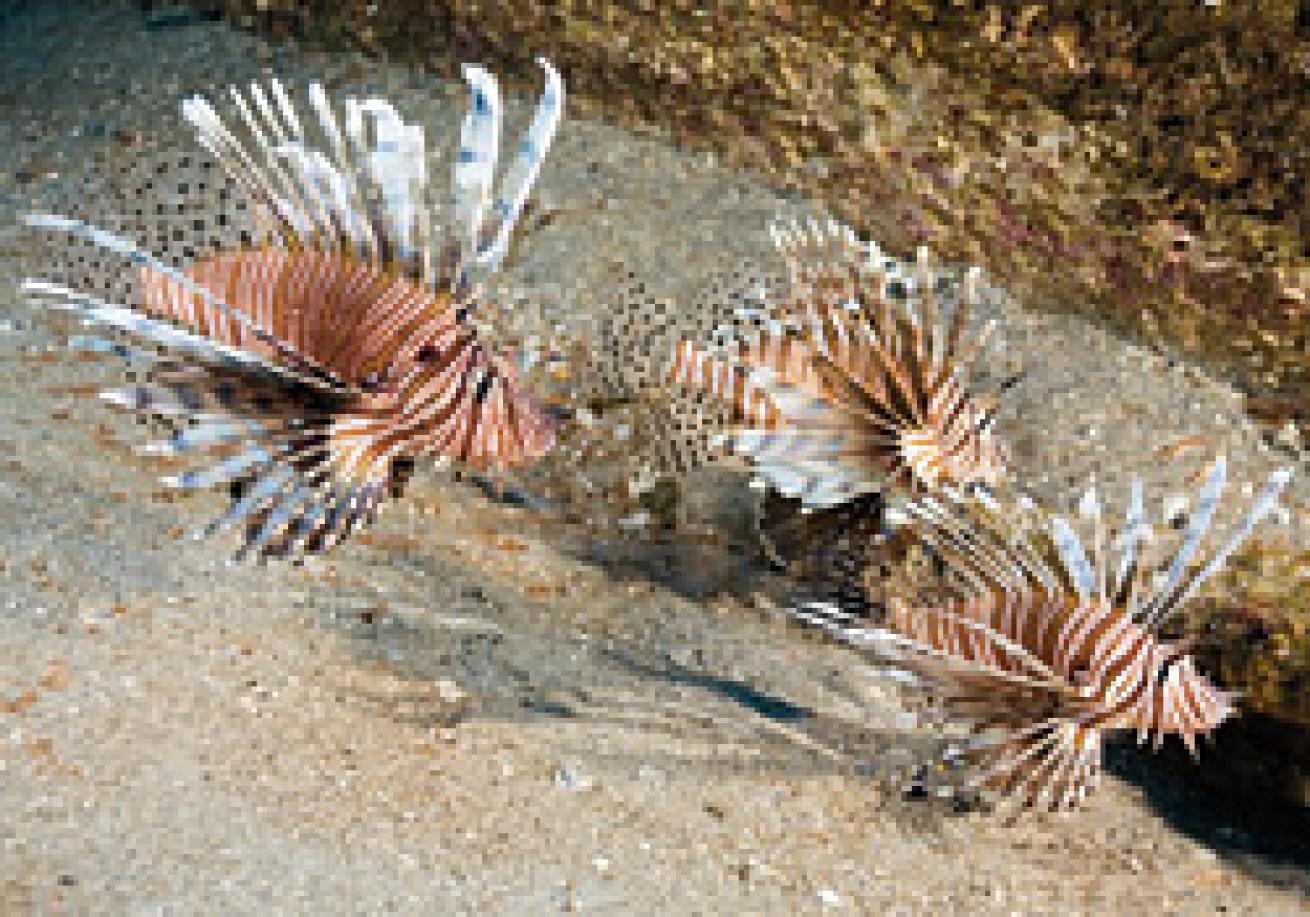
..
Home of the Sand Tigers
Not everyone who comes to dive North Carolina is here just for the wrecks. Others come to see sharks, namely sand tigers. Going face-to-face with one of these brutes is something not easily forgotten. Beneath their conical snouts are fearsome-looking jaws held partially agape as they brandish a nightmarish collection of spiky teeth.
But despite appearances, sand tigers are not monsters. There is little to fear from these slow-moving animals, which use their impressive dental assets to snare bottom-dwelling fish, not divers. Sand tigers were once a widely distributed species, found not only in North and South American waters, but Australia, South Africa, India, China and Japan. Even the Mediterranean was once known to have them before overfishing wiped them out.
These days, the most robust population of surviving sharks can be found in the waters of North Carolina. And the best place to find them is usually on a wreck. In fact, almost every wreck below 60 feet--W.E. Hutton, Suloide and Aeolus, to name a few--will attract sand tigers, and the farther out from shore, the higher their numbers.
It is the presence of sand tigers that has made the Papoose North Carolina's best-known wreck. Torpedoed by a German U-boat after rounding Cape Lookout on March 18, 1942, the 412-foot tanker lies upside down with her superstructure crushed into the sand bottom at 130 feet. Entry into the hull is possible through several openings, but penetration should be left to highly experienced and well-equipped divers.
For the most part, the ship's huge hull resembles a large watermelon, cracked open in several places, with the highest part of the wreck rising 30 feet off of the bottom at the stern. Back in the mid-1970s, salvagers managed to raise the propeller after blasting it loose from the shaft, in the process leaving a large void between the stanchion and rudder.
For fish-watchers, the wreck offers everything from large schools of spadefish, a variety of jacks, African pompano, sand tiger sharks, to--get this!--lionfish. Apparently jettisoned into the Atlantic by aquarium owners, this tropical Pacific native has made itself quite at home on most of the wrecks and deep-water ledges off the Outer Banks.
InDepth
Getting There: From I-95, the drive from the southwest on Hwy. 17 takes approximately two hours. It's about three hours if you are coming from Raleigh, six hours from Washington, D.C., and nine hours from Philadelphia.
Water Conditions: Water temps range from the low 60s to upper 60s during winter and spring and from the low 70s to the low 80s during the fall and summer. Visibility ranges from 40 to 50 feet in winter and from 80 to 100 feet in summer.
Dive Operators: Olympus Dive Center, Morehead City (252-726-9432, www.olympusdiving.com), Discovery Diving, Beaufort (252-728-2265, www.discoverydiving.com), Atlantis Charters, Beaufort (252-728-6244, www.atlantischarters.net).
Things To Do: North Carolina Aquarium, Pine Knoll Shores, Hwy. 58 west • Range of aquariums and exhibits including a Touch Tank.
The North Carolina Maritime Museum, 315 Front St., Beaufort • An impressive collection of ship models and various exhibits highlighting species of coastal birds, fish and marine mammals native to the region.
Cape Lookout National Shore, accessible only by ferry • A 55-mile-long barrier island that is uninhabited and undeveloped except for the Cape Lookout lighthouse and keeper's quarters. Outer Banks Ferry Service, (252) 728-4129.

